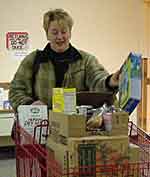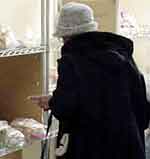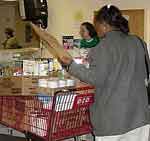By Mary Stucky
Minnesota Public Radio
December 28, 2001
|
| RealAudio |
The largest, and longest running study of hunger in America shows last year nearly half of the people using food-shelves were working, many at full time jobs. With the economy in recession, Second Harvest officials are braced for an unprecedented need for emergency food.
| |
|
|
|
||
Once a month, Cheryl Malm pushes her shopping cart through America's Second Harvest's enormous food warehouse in St. Paul. It's soon brimming with boxes.
"I've got some cereal and yogurt. Hannah Grace loves yogurt. She'll be eating that and some beans and raisins, beef stew, pasta," Malm says.
Cheryl Malm doesn't fit the "needy person" stereotype. Her husband works full time in a shipping department. She's a part-time nurse. But with the cost of housing and medical insurance for their family with three kids, the Malms just don't earn enough to make ends meet. The local Second Harvest food program, called Mothers and Children or MAC, got them through an especially tough time when they were stretching their money to buy a house.
"It was really hard - tight, tight money - and we had to depend on that MAC. It gets kind of emotional, to make us food-wise. It was hard," Malm says.
Last year, 23 million people across the country used Second Harvest services - soup kitchens, church pantries, food shelves and homeless shelters. Second Harvest's director of public policy and research, Doug O'Brien, says there has been a steady increase in hunger in America, even through the boom years of the 1990s.
"One of four people in a soup kitchen line is now a child," says O'Brien. "In the 1980s, you almost never saw children in soup kitchens. They were serving homeless men. Now you're nearly as likely to see a single parent with kids in a soup kitchen line."
| |
|
|
|
||
Jim Weil, president of the Food Research and Action Center in Washington D.C., says the U.S. may be the world's richest society, but it's done little to help low income working families.
"If you work a full-time minimum wage job now, it gets to about 80 percent of the poverty line for a family of three," Weil says. "Our distribution of income has become so unequal that we have this permanent problem of people having to rely on resources like emergency food banks."
In recent years, participation in the government-run food stamp program has plummeted. Welfare reform pushed people into the job market. Many of those people became ineligible for food stamps, but their wages weren't enough to make up for the loss of the stamps. Meantime, the cost of housing, medical insurance and prescription drugs skyrocketed.
Thirty percent of those in the Second Harvest study said they were trading off between paying for medicine and food - the same with utilities and housing. This is not news to Christine Anderson, who helps run the Second Harvest food programs in St. Paul.
"There's a lot of people in your own backyard that you don't expect to be using the food shelf. People are working two, three jobs trying to make ends meet," Anderson says.
But not everyone agrees that the problem of hunger in America worsened in the 1990s.
| |
|
|
|
||
Robert Rector, senior research fellow with the Heritage Foundation, thinks the number of people using Second Harvest food services does not accurately reflect the number of hungry people in America.
"If you look at the U.S. Department of Agriculture's own surveys, they show there is a problem of hunger in the United States but it is a relatively small scale. Perhaps 3 percent of the U.S. population could be considered hungry, and even that isn't that severe," Rector says.
But America's Second Harvest says just one hungry person in America is unacceptable. Second Harvest officials say one answer is to become more generous with government food aid like food stamps. The Food Research and Action Center's Jim Weil agrees.
"The food stamp program eliminated hunger in this country in the 1970s, and then as it was weakened in the '80s and '90s, it did that job less well. And we could eliminate hunger in this country," Weil maintains.
Some say food stamps are a much better way of getting food than through a food shelf or soup kitchen.
There are provisions to expand the food stamp program in the farm bill currently before Congress. That bill is far from finalized and with the country in recession, there's concern it won't be enough to address the problems of hunger in America.
The Second Harvest study covered the time period through April 2001. Local food shelves around the country report that after Sept. 11 donations are down, while demand continues to grow.
More from MPRMore Information



